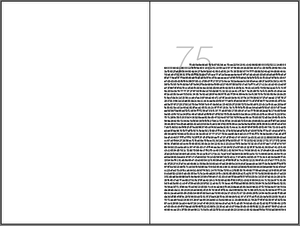User:Lbattich/Narratives/Photo Book Proposals
- "Perhaps the hardest thing to do in connection with the aritst's book is to find the right language to discussing it. Most of our criticism in art is based on the concept of a work with separable meaning, content and style... But the language of normative criticism is not geared toward the discussion of an experience, which is the main focus of most artist's books."
- Dick Higgins
- "Everything in the world exists in order to end up as a book."
- Stéphane Mallarmé
- "Plagiarism is the starting point of the creative activity in the new art."
- Ulises Carrión
The Photo Book - General Context & Research notes
Questions to keep in mind: What is a photo book in the time of digital technologies? What is a book and what is an artist publication?
What is the relation of a photo book and photography? Does a photo book necessariliy has to contain, or explicitly relate to photography as a medium?
Why not a cinema book? or a film book?
My own approach to the artist book has been shaped to some degree by Ulises Carrión's 1975 influential manifesto "The New Art of Making Books". In this text Carrión presents a new conception of the books arts that relied on bringing the book closer to sculpture. The main point is that the book is not a mere artefact that carries information, a mere container of (literary) texts. Rather, "a book is a space-time sequence."
Ulises Carrión wants us to acknowledge that a book is an artefact in its own right, a medium which does not necessaily depend on the information contained (printed) in it. The same could be said of digital media. With modernist tact, Carrión wanted to relish in the qualities of the medium of the book as object: "The most beautiful and perfect book in the world is a book with only blank pages, in the same way that the most complete language is that which lies beyond all that the words of a man can say."
On reading:
- "In order to understand and to appreciate a book of the old art, it is necessary to read it thoroughly.
- In the new art you often do NOT need to read the whole book.
- The reading may stop at the very moment you have understood the total structure of the book."
Previous work on the notion of digital / analogue relation of books and photographs:
- A book that presents a photograph (reproduction) of a painting, in its binary form, its digital form:
Series Musée Binaire:
Musée Binaire is an "illustrated" art history book series. Each book presents the image of an artwork in its digital manifestation through hexadecimal code (every pair of alphanumeric characters constitutes a byte of information.)
Proposals
1st Proposal: E.H. Gombrich's The Story of Art
Description: A page by page reproduction of an edition of E.H. Gombrich's The Story of Art, with all text removed, and preserving the images in their original layout.
Context & aims:
First published in 1950 by Phaidon, E.H. Gombrich's The Story of Art is widely regarded both as a seminal work of art criticism and as one of the most accessible introductions to the visual arts. After more than 60 years of continuous publication and renewed editions, it is currently the best selling art book of all time. Gombrich's survey of art and his brand of criticism have thus become highly influential for several generations of art historians, artists and their publics, and art professionals generally.
The intention in reproducing the book with all text removed is based on Andre Malraux's notion of the "museum without walls" (musée imaginaire). With this term, Malraux argues that the advent of photographic reproduction of artworks has created a vision or generalized idea of an imaginary global museum of the world's artistic heritage. The use of photographs in scholarly studies on art has given the impression of the field art as a compact totality, and allowed comparision between consolidated styles.
However, digital media and the accesibility and proliferation of information has somehow changed the status of the photographic reproduction, especially as most images circulate without the appropriate context, without the scholarly and expert commentary that had accompanied these images.
Given the prominence of photographic reproduction in Gombrich's monograph, the proposed publication seeks to examine how these reproductions work within the book, without the expert's words to direct their interpretation.
Introduction and first chapter example: File:Gombrich-chap1.pdf

